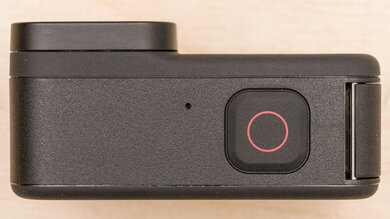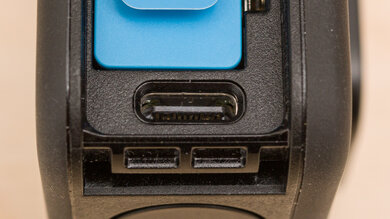The GoPro HERO10 Black is a feature-packed action camera. It's effectively an upgraded version of the GoPro HERO9 Black, as its new processor yields faster overall performance. Unlike its predecessor, it can record 4k video at up to 120 fps without a crop, which is fantastic for shooting very smooth action video or generating high-quality slow-motion clips. It does an exceptional job smoothing out camera shake, handy for users who prefer recording without using a gimbal. Unfortunately, it offers a fairly limited range of exposure adjustments, and it can overheat when recording for extended periods.
Our Verdict
The GoPro HERO10 is poor for travel photography, though this isn't its intended use. The adjustment range for shutter speed is very limited, and the lens has a fixed aperture. It also isn't meant to be used handheld, though it does feel very well-built. While the lens' focal length is fixed, it does have several digital lens modes that you can use to simulate different focal lengths. Image quality is also relatively sharp and low in noise when shooting at moderate ISO levels.
- Compact design.
- Superb build quality.
- Excellent image quality.
- Shutter speed adjustment range is limited.
- Fixed aperture.
- Not meant to be used handheld.
- Limited ISO range in photography.
The GoPro HERO10 isn't intended for high-level landscape photography, though it can capture stills in a pinch while you're out on a hike or traveling.
The GoPro HERO10 isn't intended for this use. It has a maximum burst rate of 25 fps, which can help capture stills of fast-moving subjects in pinch. However, its limitations as a still camera make it unsuitable for proper sports or wildlife photography.
The GoPro HERO10 can shoot photos in RAW format, but we don't test action cameras for RAW image quality.
The GoPro HERO10 is a good option for vlogging. Its lightweight, compact design makes it easy to carry around for a full day of use. Its secondary front-facing display allows you to monitor yourself even when the camera is pointed at you. It also does an excellent job smoothing out camera shake while recording handheld, though its digital stabilization feature does incur a 1.36x crop when set to its most effective mode.
- Excellent video stabilization performance.
- Compact design.
- Can shoot in a wide variety of resolutions.
- Secondary display lets you see what's being shot while self-recording.
- Mediocre video quality in low-light.
- Can overheat during longer recording sessions.
The GoPro HERO10 Black is mediocre for studio video, though it isn't designed for this. Video quality is alright overall, though some noise is present when shooting in dimmer areas, while object contours and surfaces could be more sharply rendered. That said, it can record video in 5.3k, 4k, 2.7k, and FHD, giving you a wide range of resolutions to choose from. However, it can also interrupt your recording by overheating during longer recording sessions. It has a fairly limited selection of inputs and outputs for different videography accessories, though a Media Mod kit with additional ports can be purchased from the manufacturer.
- Wide selection of frame rates in most resolutions.
- Can shoot in a wide variety of resolutions.
- Mediocre video quality in low-light.
- Can overheat during longer recording sessions.
The GoPro HERO10 is an excellent choice for action video. It feels remarkably sturdy, with a high-grade plastic body that's advertised as being waterproof to a depth of 33 ft. It's very compact and designed to mount to a wide variety of objects, ranging from chest and helmet rigs to sports cars and aircraft. It delivers amazing overall video stabilization performance, which is helpful if you plan to record without using a gimbal. Its horizon-leveling feature also helps keep videos steady when tilting the camera from side to side. It can record 4k video at up to 120 fps, which is fantastic if you want to shoot high-quality slow-motion footage or very smooth action video.
- Wide selection of frame rates in most resolutions.
- Excellent video stabilization performance.
- Compact design.
- Superb build quality.
- Can shoot in a wide variety of resolutions.
- Mediocre video quality in low-light.
- Can overheat during longer recording sessions.
Changelog
- Updated Jan 29, 2024: Added text to the 'Raw Photo Performance' verdict box and updated existing verdict boxes for clarity and accuracy.
- Updated Jan 29, 2024: Converted to Test Bench 0.12.1.
- Updated Mar 22, 2023: Added a link to the DJI Action 2 in the 'Portability' box.
- Updated Dec 21, 2022: Converted to Test Bench 0.12.
Check Price
Differences Between Sizes And Variants
The GoPro HERO10 Black is only available on one color variant: Black, and you can see our test unit's label here.
Let us know in the discussions if you come across another variant.
Popular Camera Comparisons
The GoPro HERO10 Black is better than the DJI Osmo Action. The GoPro has more frame rate and resolution options, including 5.3k video up to 60 fps and 4k video up to 120 fps. It also has better stabilization performance, more field of view options, and better video quality, especially in low light.
The GoPro HERO10 Black is better than the DJI Action 2. It has a more conventional design, and while it isn't as portable, it doesn't struggle with overheating in the same way that the DJI does. It also has a longer battery life and slightly better video quality. Unlike the DJI, the GoPro can also record 5k video at up to 60 fps.
The GoPro HERO10 Black offers a few improvements over the GoPro HERO9 Black, including a new processor, which gives it improved low-light performance, as well as offering more frame rate options. Otherwise, they're both excellent action cameras with near-identical builds and front-facing selfie screens.
If you're looking for an action camera, the GoPro HERO10 Black is a better choice than the Sony RX0 II. Though it isn't as ruggedly built and doesn't give you as much control over settings and focus, the GoPro gives you more frame rate and resolution options and better video stabilization.
Test Results

If you're looking for a camera with a more portable, modular design, consider the DJI Action 2.
- Very similar in appearance and construction to the GoPro HERO9 Black
- Materials feel very robust and solid
- Sturdy hinge with a rubber gasket covering inputs for water resistance
- Input door is hard to open
- Advertised as being waterproof to a depth of 33 ft (10 m)
Note: This camera has a set of pop-out 'Folding Fingers' that are compatible with a wide variety of accessories.
- Not intended to be used handheld, but is still comfortable to hold in one hand
- Can change settings using the touchscreen or via the GoPro app on your smartphone, though you can't use the app to adjust 'Protune' settings, which include shutter speed, ISO, while balanced, and EV compensation
- Touchscreen responds to inputs much faster than the GoPro HERO9 Black. You can see a comparison between the two models here.
- Buttons are hard to press due to waterproofing layer but offer ample physical feedback
This camera has an additional screen on the front that can be used for Live View while recording and also displays information like shooting mode, battery life, and SD card info. If you prefer a screen that can tilt to help you shoot at different angles, check out the Sony RX0 II.
- Menu is simple to use and easy to navigate
- You can access all the camera settings on the GoPro phone app, though the app doesn't allow you to make any changes to shutter speed, ISO, white balance, and EV compensation due to the removal of all 'Protune' settings in an app update from January 2021.
- Guide Mode is available for additional information about settings and features
Note: This test was conducted using the 'Wide' digital lens setting to maintain consistency with other action cameras.
Note: The camera's maximum ISO in photo mode is ISO 3200, but using the camera in video mode increases its maximum ISO to ISO 6400.
Note: If you choose to use the camera when it's plugged into an external power source, the battery stops charging, and the camera draws power from this external power source. As soon as the recording stops, the battery starts charging again. This information is also conveyed in the instructional manual.
Note: Our current test methodology can't adequately score the image stabilization features of cameras with limited slower shutter speed settings. Note, though, that this camera still has stabilization features and the score is not representative of how these features perform in actual use.
Note: This camera is capable of recording 5.3 and 2.7k video, along with the standard 4k and FHD resolutions. A 5.3k test scene extract can be seen here while a 2.7k test scene extract can be seen here. The following table illustrates the relative frame sizes of each video resolution, while this table gives a full breakdown of the frame rates that can be used in each resolution. This camera also has a horizon-leveling feature that can level out a scene up to a 45-degree angle. You can see this feature in action here. You can also choose from five different digital lens modes that simulate different focal lengths: 'SuperView' (16mm), 'Wide' (16-34mm), 'Linear' (19-39mm), 'Linear + Horizon Leveling' (16-34mm), and 'Narrow' (27mm). This slideshow demonstrates how each mode affects framing.
Note: This camera uses the HVEC codec by default, but it can be configured to use both HVEC and H.264 codecs. The manufacturer recommends using Handbrake to convert HVEC videos to H.264 if the former codec causes you any issues.
















